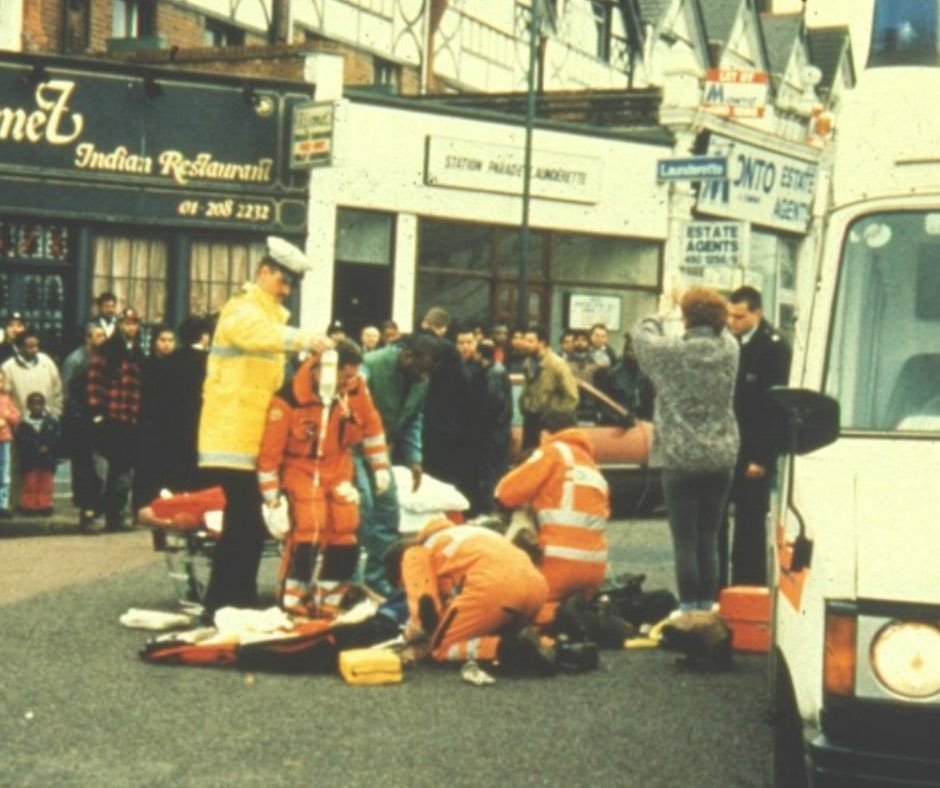The first prehospital thoracotomy performed by London’s air ambulance service outside an Indian restaurant on Christmas Eve 1993
Preshospital surgery, once seen as fanciful, perhaps even reckless is now a normal occurrence in parts of the world.
The headline act has to be the prehospital resuscitative thoracotomy. Ironically, the world’s first successful prehospital thoracotomy was performed in Houston in 1988 by Matthew J Wall M.D., then a senior surgical resident who was riding along with the Houston Fire Department EMS as a physician-observer. Yet, despite being pioneers in the field, American EMS services have never embraced the procedure as a part of their on-scene armamentarium. Indeed, the idea of putting doctors out in the field remains something of an anathema.
Other services around the world have led the way, most notably London’s Air Ambulance services (also known as HEMS- Helicopter Emergency Medical Service). London HEMS is renowned for its innovative culture and have embraced new technologies that allow them to bring the resus bay, OR and ICU to the patient. There is a realisation that the ‘stay and play’ school of thinking almost certainly has a place when it comes to dealing with the exsanguinating patient in extremis.
London HEMS operates a helicopter by day and a fleet of cars by night as London’s narrow streets and ample obstacles prevent safe night-landing. The teams comprise 1 or 2 specialist prehospital physicians alongside a flight paramedic seconded from the regular London Ambulance Service (LAS). Emergency calls to LAS HQ are screened 24/7 for suitability for HEMS dispatch. Certain injury patterns or mechanisms will trigger an immediate dispatch i.e. penetrating central chest injury, falls from significant height or person under a train. Other times the call may be interrogated by a dedicated HEMS paramedic at the call centre to ascertain suitability. Regular EMS crews are also able to request HEMS attendance once they arrive on scene and the picture becomes clearer. The team is dispatched from their home base atop the Royal London Hospital in the city’s East End. The service also forms a key part of London’s Major Incident response plan. The physicians are for the most part ED or anaesthesia/ICM trainees or consultants (attending physicians), however historically a steady stream of surgical residents (often with military backgrounds) have brought their skillset to the mix. Surgical leadership in the training of prehospital physicians is crucial for obvious reasons. The unit’s Clinical Lead is Karim Brohi, world-renowned Professor of Trauma Surgery who himself was a HEMS flight physician in his residency years.
Prof Karim Brohi and a HEMS crew atop the Royal London Hospital
So, is prehospital thoracotomy a procedure worth doing? A 2011 case series of 71 prehospital thoracotomies carried out by the London HEMS service produced 13 survivors (18%), with good neurological outcome in 11 of the 13. This success rate is in keeping with survival rates of 21% for emergency department thoracotomy in penetrating trauma patients with signs of life reported in a large US systematic review in 2015.
Prehospital thoracotomy is just one of the advanced capabilities brought to the scene by HEMS. The ability to perform emergency anaesthesia, administer blood products, antifibrinolytics and reverse anticoagulants all add to an advanced capabilities the team can bring to the most severe of trauma cases.
One of the more recent innovations is prehospital REBOA (Retrograde Endovascular Balloon Occlusion of the Aorta), which effectively replaces the need to perform thoracotomy for distal haemorrhage control (i.e. abdominal and pelvic haemorrhage). The operator gains access to a femoral vessel using a standard ultrasound-assisted Seldinger technique then sites a balloon catheter at a suitable location within the aorta before inflating. Patients routinely arrive in the OR with the REBOA balloon in-situ. An ED doctor or suitably trained REBOA operator takes the reins and works with the trauma surgeons on table to deflate or re-inflate the balloon as required whilst damage-control surgery is underway.
The ability to perform such daring feats in the prehospital arena which then blend seamlessly into the in-hospital environment relies not just on innovation but senior institutional buy-in. Hospital chiefs and program directors must be on hand to provide political and medicolegal cover to the doctors out in the field performing procedures that traditionally had no place being performed outside of a hospital. No one is suggesting that having an anaesthetist open a chest in a dark alleyway is preferable to having a trauma surgeon do so in a well-lit fully equipped OR. However, when faced with the choice of almost certain death vs a 20% chance of survival, I know which option I’d choose for myself or anyone I cared about. Training and experience are key, as is the development of standard operating procedures that detail the suitable target patient population for the procedures available.
Future trials of new devices and pharmacological adjuncts are to be expected including prehospital ECMO, which has been used outside of hospital in other European countries, most famously in the Louvre in Paris.
Steve Jobs once said that innovation is the ability to see change as an opportunity- not a threat. US institutions would do well to embrace a more innovative outlook when it comes to prehospital care and continue to legacy that was started in Houston in 1988.
Obi Nnajiuba is a British surgical resident with a specialist interest in trauma, acute care, prehospital care, triage, mass casualty events and trauma systems. His postgraduate qualifications include an MSc in Trauma Sciences and membership of the Royal College of Surgeons of England. He is also a registered Motorsport UK physician, providing trackside advanced trauma care to competitors at world famous motor-racing circuits such as Brands Hatch, Goodwood and Silverstone.



